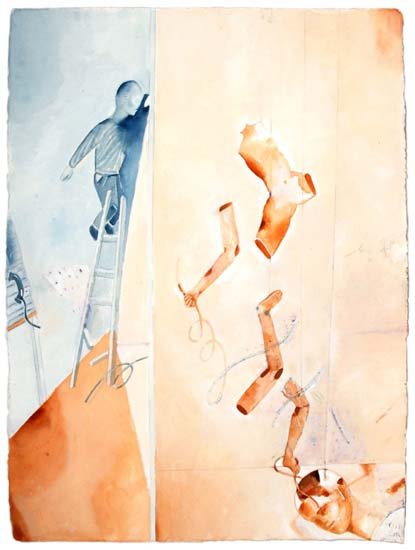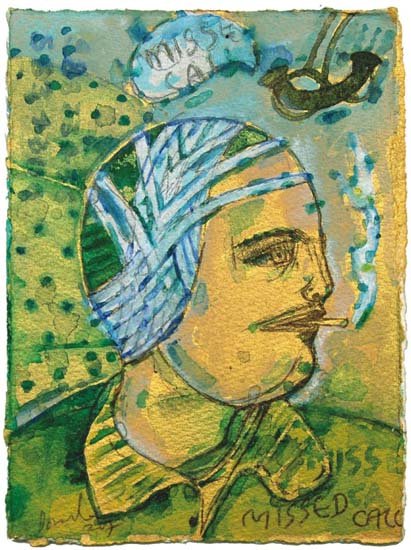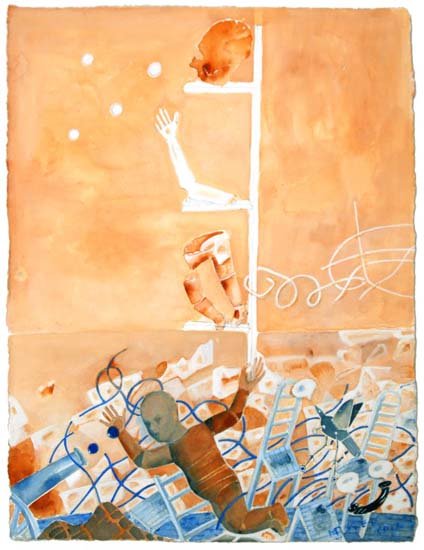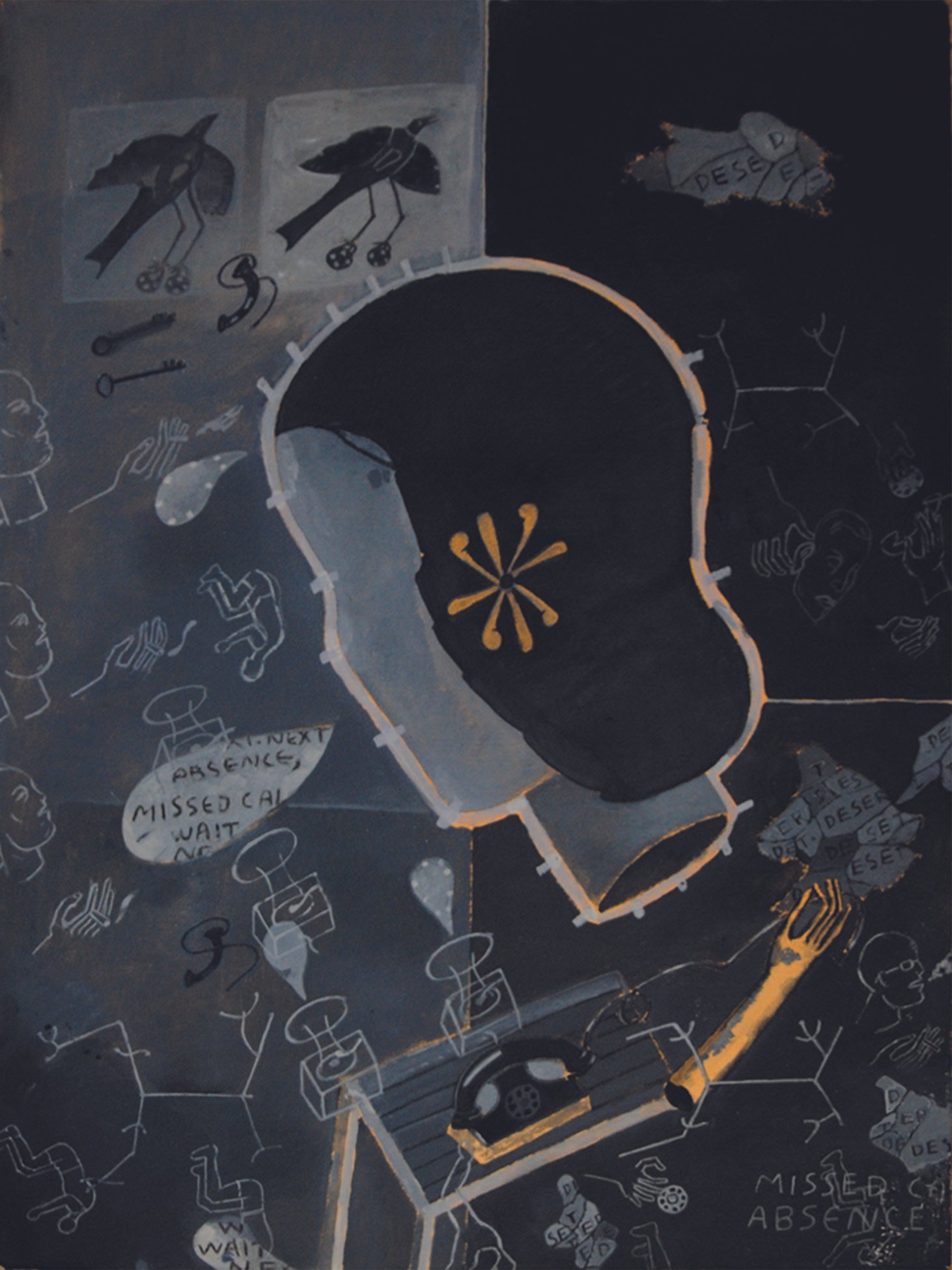
Missed Call- C Douglas
October 25 - November 10, 2008
Fragmentation, absence and emptiness are conveyed in C. Douglas’s paintings through a non-hierarchical arrangement of disjointed mannequins, broken ladders, phones with receivers off the hook, toy birds etc.
Through these missed call-like representations, where there could be a presence 'within' an absence, a sense of expectation is created among the viewers. While the missed call signifies the absence and anticipation for the elusive truth, it also refers to a certain distance and displacement, as the self waits for the presence or the call from the other. Since the self is defined by the other as well, the absence of the other, implies the loss of specificity and identity of the self. So the ‘I’ becomes a lifeless, broken and anonymous mannequin.
‘Douglas’s figure is that of an unbearable being, one that would have been grateful not to have been brought forth at all.’ - Joseph James
The limp foetal figures of his earlier works are now born from the seed-like telephone receiver as helpless, inanimate mannequins that are controlled by the strings of destiny. In the 12-year gestation period between his last solo show and the Missed call series, the undifferentiated self of foetus has also ‘grown’ into the emptiness, absence and abjection of the self in the mannequin. Where the foetal figures were suspended passively in the murky amniotic fluid of the background, there is now a certain frozen participation as the inside and the outside space fluidly interpenetrate in the hollow mannequin, broken ladder and the eye of the needle.
The recurring image of the phone receiver off its hook which is used by Douglas to signify a missed call, in a literal sense, could also convey isolation and an unwillingness to communicate. Similarly the images of men with bandaged ears are a reference to the deafening silence that is enforced due to the absence of the call, while at the same time being a historical reference to Van Gogh who severed his own ear. These overlapping yet fragmented images on the one hand, express certain aloofness and self-enclosed completeness and on the other, indicate incompleteness, since there is an 'absence' even from within what we expect them to be. This contradictory quality is also reflected in the idea of a missed call, which can not only signify absence and lack, but also completeness, since, a missed call is a brief yet complete form of contemporary communication. Like the metallic shades used in this series which can convey great depth and at the same time no depth, these paintings deconstruct and put into play binaries such as complete/incomplete, depth/flatness etc.
An artist with an interest in reading critical theory and philosophy, Douglas’s paintings engage with the image/text association by juxtaposing images with words such as ’missed call', 'absence' etc. These texts simulate speech, since they are often written in blurbs placed near sources signifying 'presence', yet are actually written (or painted) words, conveying absence, that proceed from an absently presence, such as a mannequin or a dangling telephone receiver. Ironically, the speech-like text could also be read as a reference of the absence of voice and hearing in the mute and mutilated figures. While the paintings combine both images and words, the dismembered figures communicate through the written and read words, as well as the multitude of gesturing hands.
The painting surface could be compared to an arena where a game is played between the images of ladders and those of snake like curvilinear forms that end in piercing needle tongues or hanging phone receivers that mutilate through their silence. However, unlike a game of snake and ladder, here there is an absence in the traditional hierarchy as the broken ladders are ineffective in reaching the goal while the piercing needles could stitch back the fragments and thereby lead to the whole.
Ladders are also tools that help to bridge two levels which physically and often psychologically are of varying hierarchies. Thus the broken ladders mirror the non-hierarchical, postmodern quality of the painting surface, where there is a fragmentation as the centre is transported to the margin.
‘Because the whole series of pertinent events is practically present in the latest, in the same way that the six digits already dialled on the telephone are contained in the seventh, an aesthetic act is irreducible to any other act in a different place in the series and the series itself tends towards uniqueness and irreversibility’. -Pierre Bourdieu
Akin to a series of telephone numbers in the same locality where each telephone number is unique, yet distinguished only through the slight variation in the sequence of digits, the paintings in the Missed call series have been conceived in thematically and visually related sets. The series is thus composed of fragments, which remain separated at a physical level, yet adhere together to form a whole when the mode of perception shifts to a visual and conceptual plane. Talking on a mobile phone has a similar effect, as this act controls and dictates the way one walks, moves and gestures. However this could be regained when discussing the same issue, using only a slightly altered mode of communication, namely the conventional, land phone.
This work consists of four pieces arranged in a linear pattern to form a polyptych. But unlike the precarious disjoining and rejoining that occurs with the work itself, the mannequins within the painting, remain helplessly severed and disjointed. Through their anonymity and hollowness, the mannequins convey a displacement of identity, emptiness and abjection of the self with the ‘I becoming it’. Constructed in areas with metallic gold shades, the reference is to the mirror where the image/identity created is a combination of the self and the surroundings. However, there is a certain contingency and cruelty as this identity could be lost to the other, like the grey areas of the mannequin which could be swallowed by the grey background.
The presence/absence which separates the real from the imaginary and also vice-versa, the sequence of numbers which distinguishes the awaited call from the wrong number and the critical difference which separates the gestures of an ordinary person from those of the visually and hearing impaired, have a certain fragility / is born of a fragility. This fragility is mirrored in the series where smaller works are conceived and arranged to create a large work. Once the series travels out of the spatio-temporal boundaries of the exhibition, one does not know whether the paintings will ever be destined to come together again in the same sequence to form a whole or, like the mannequins, remain helplessly as fragments which can only be viewed separately in different art collections. Therefore the fragmented nature of the works, their coming together as one large work in the exhibition space, the imminent severing of the already fragmented works and their ambivalent future as a collective entity become metaphors, for what Douglas describes as, ‘the contingency and fragility of the final vocabulary’.
- V.R.Vaishnavi
C. Douglas | Missed Call 1 | 30 x 22 in
C. Douglas | Missed Call 21 | 30 x 22 in
C. Douglas | Missed Call 3 | 7.75 x 5 in
C. Douglas | Missed Call 22 | 7.75 x 5 in
C. Douglas | Missed Call 2 | 7.5 x 5 in
C. Douglas | Missed Call 5 | 30 x 22 in
C. Douglas | Missed Call 4 | 30 x 22 in
C. Douglas | Missed Call 36 | 10 x 7 in
C. Douglas | Missed Call 35 | 30 x 22 in
C. Douglas | Missed Call 19 | 7.5 x 5 in
C. Douglas | Missed Call 41 | 10 x 8 in
C. Douglas | Missed Call 25 | 30 x 22 in
C. Douglas | Missed Call 2 | 7.5 x 5 in
C. Douglas | Missed Call 9 | 7.75 x 5 in
C. Douglas | Missed Call 26 | 40 x 30 in
C. Douglas | Missed Call 29 | 40 x 30 in
C. Douglas | Missed Call 28 | 40 x 30 in
C. Douglas | Missed Call 27 | 40 x 30 in
C. Douglas | Missed Call 42 | 29.75 x 22 in
C. Douglas | Missed Call 39 | 29.5 x 22 in
C. Douglas | Missed Call 24 | 30 x 22 in
C. Douglas | Missed Call 17 | 7.5 x 5 in
C. Douglas | Missed Call 20 | 7.5 x 5 in
C. Douglas | Missed Call 32 | 7.5 x 5 in
C. Douglas | Missed Call 16 | 7.5 x 6 in
























